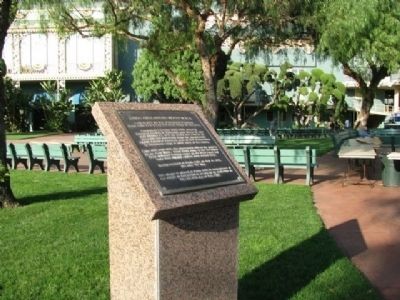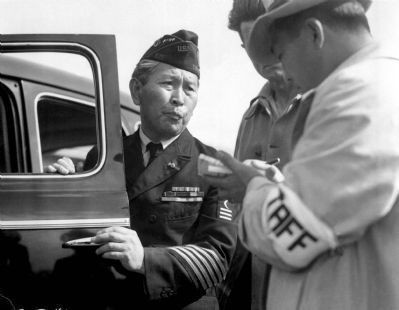Santa Anita Park During World War II-Japanese Relocation and Military Training Centers
Introduction
Text-to-speech Audio
Santa Anita Park served two purposes during WWII. From March 1942 until October 1942, it served as an assembly and processing center for Japanese Americans prior to their displacement of internment camps across the United States. In all, over 20,000 Japanese Americans were processed there. After October 1942 until 1945 the property was utilized as the largest ordnance training center on the West Coast --Camp Santa Anita. During these years, over 100,000 soldiers were trained there. Prior to the war Santa Anita Park served as a horse racing park. Racing resumed after VE day in May 1945.
Images
The marker near the grandstand commemorating the use of Santa Anita Park during WWII.

An unidentified navy veteran of Japanese ancestry reports to the assembly center for processing.

Backstory and Context
Text-to-speech Audio
After the bombing of Pearl Harbor, Pres. Franklin Roosevelt ordered the evacuation of Japanese Americans to internment camps. While these camps were being hastily constructed, the Japanese Americans were housed at processing centers. The vast area of Santa Anita Park served this purpose for housing these persons from San Diego and Santa Clara counties in California.
When Japanese Americans arrived, they were given an army cot, blanket and straw tick which they used in rows and rows of barracks that were constructed on the park's parking lot. More than 8,000 lived in converted horse stables that some claimed never lost the stink of manure. The race track was surrounded with barbed wire and searchlights.
Once the Japanese Americans has been evacuated to their respective internment camps, the park was converted to an army base. where more than 100,000 soldiers were trained in weapons, ammunition and combat vehicles.
In 2001, a marker was placed close to the grandstand of the racetrack commemorating this segment of the racetrack's history.
When Japanese Americans arrived, they were given an army cot, blanket and straw tick which they used in rows and rows of barracks that were constructed on the park's parking lot. More than 8,000 lived in converted horse stables that some claimed never lost the stink of manure. The race track was surrounded with barbed wire and searchlights.
Once the Japanese Americans has been evacuated to their respective internment camps, the park was converted to an army base. where more than 100,000 soldiers were trained in weapons, ammunition and combat vehicles.
In 2001, a marker was placed close to the grandstand of the racetrack commemorating this segment of the racetrack's history.
Cite This Entry
Admin, Clio. "Santa Anita Park During World War II-Japanese Relocation and Military Training Centers." Clio: Your Guide to History. August 4, 2016. Accessed March 31, 2025. https://theclio.com/entry/4928

